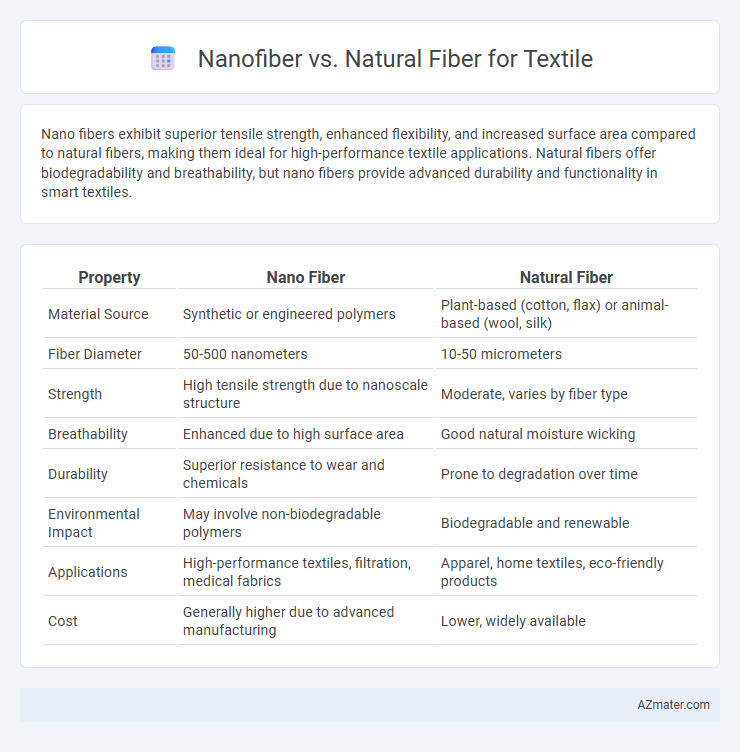Nano fibers exhibit superior tensile strength, enhanced flexibility, and increased surface area compared to natural fibers, making them ideal for high-performance textile applications. Natural fibers offer biodegradability and breathability, but nano fibers provide advanced durability and functionality in smart textiles.
Table of Comparison
| Property | Nano Fiber | Natural Fiber |
|---|---|---|
| Material Source | Synthetic or engineered polymers | Plant-based (cotton, flax) or animal-based (wool, silk) |
| Fiber Diameter | 50-500 nanometers | 10-50 micrometers |
| Strength | High tensile strength due to nanoscale structure | Moderate, varies by fiber type |
| Breathability | Enhanced due to high surface area | Good natural moisture wicking |
| Durability | Superior resistance to wear and chemicals | Prone to degradation over time |
| Environmental Impact | May involve non-biodegradable polymers | Biodegradable and renewable |
| Applications | High-performance textiles, filtration, medical fabrics | Apparel, home textiles, eco-friendly products |
| Cost | Generally higher due to advanced manufacturing | Lower, widely available |
Introduction to Nano Fiber and Natural Fiber in Textiles
Nano fibers in textiles offer enhanced strength, durability, and functionality due to their extremely small diameters, often measured in nanometers, enabling improved moisture control, filtration, and antimicrobial properties. Natural fibers, such as cotton, wool, and silk, are derived from plant or animal sources and are valued for their breathability, biodegradability, and comfort in textile applications. Comparing nano fibers and natural fibers highlights differences in mechanical performance, sustainability, and potential uses within advanced and traditional textile manufacturing.
Composition and Structure: Nano Fiber vs Natural Fiber
Nano fibers in textiles are composed of synthetic polymers like polyvinyl alcohol (PVA) or nylon, featuring diameters typically below 100 nanometers, which provide a high surface area-to-volume ratio and enhanced mechanical strength. Natural fibers such as cotton, wool, or silk consist of cellulose, protein, or keratin with a hierarchical structure including microfibrils, contributing to their breathability and biodegradability. The ultra-fine and uniform structure of nano fibers allows for superior filtration and moisture management compared to the heterogeneous and variable microstructure of natural fibers.
Manufacturing Processes: Modern vs Traditional Techniques
Nanofiber production in textiles relies on advanced techniques like electrospinning, which allows for precise control over fiber diameter and morphology at the nanoscale, enhancing material properties such as strength and breathability. In contrast, natural fiber manufacturing typically involves traditional processes like harvesting, cleaning, carding, spinning, and weaving, which are labor-intensive and less controllable in fiber uniformity. The modern nanofiber techniques enable faster production rates and customization, offering superior performance and scalability compared to the conventional methods used for natural fibers.
Mechanical Properties: Strength, Flexibility, and Durability
Nanofibers in textiles exhibit superior mechanical properties, with tensile strength reaching up to several gigapascals due to their high surface area-to-volume ratio and molecular alignment. Natural fibers such as cotton, wool, and silk offer moderate strength ranging from 200 to 800 MPa but excel in flexibility and biodegradability, making them ideal for comfort-focused applications. Durability in nanofibers surpasses natural fibers by resisting wear and environmental degradation, resulting in longer-lasting textiles engineered for high-performance and protective clothing.
Environmental Impact and Sustainability Considerations
Nanofibers in textiles offer enhanced durability and water resistance but often rely on synthetic polymers derived from non-renewable resources, raising concerns about biodegradability and microplastic pollution. Natural fibers such as cotton, hemp, and flax are biodegradable and sourced from renewable plants, reducing environmental footprint through lower energy consumption and carbon emissions during production. Sustainable textile practices increasingly emphasize natural fibers for their soil health benefits and recyclability, while research into bio-based nanofibers seeks to improve eco-friendliness without sacrificing performance.
Applications in the Textile Industry
Nano fibers in the textile industry offer superior properties such as enhanced strength, breathability, and moisture-wicking capabilities, making them ideal for high-performance sportswear and medical textiles. Natural fibers like cotton and wool dominate in comfort and biodegradability, widely used in casual apparel and home textiles for sustainability-conscious consumers. The integration of nano fibers with natural fibers in hybrid textiles facilitates innovative applications, combining durability and eco-friendliness across fashion and technical textile markets.
Comfort, Breathability, and Wearability
Nanofibers in textiles offer superior comfort by providing enhanced softness and lightweight properties compared to natural fibers like cotton or wool. Their high surface area improves breathability, allowing better moisture wicking and temperature regulation, which natural fibers may lack under intense physical activity. Wearability of nanofiber-based fabrics often exceeds that of natural fibers due to increased durability and resistance to wear and tear without sacrificing flexibility.
Cost Efficiency and Market Trends
Nano fibers in textiles offer superior cost efficiency due to their enhanced durability, lightweight properties, and reduced material usage, which lowers production expenses over time. Natural fibers maintain steady market demand driven by consumer preference for sustainability and biodegradability, but often incur higher costs associated with cultivation and processing. Market trends reveal increasing investment in nano fiber technology for performance textiles, while natural fibers retain appeal in eco-conscious segments, indicating a dual growth trajectory in textile innovation and sustainability.
Technological Innovations and Advancements
Nanofibers in textiles offer exceptional mechanical strength, enhanced breathability, and superior moisture management compared to traditional natural fibers like cotton or wool. Technological advancements such as electrospinning and functional nanocoatings enable the production of ultrafine fibers with tailored properties for applications in smart textiles and high-performance sportswear. Innovations in nanofiber composites also improve durability, antimicrobial effects, and thermal regulation, positioning nanofibers as a cutting-edge alternative to conventional natural fibers in modern fabric engineering.
Future Prospects and Challenges
Nano fibers offer exceptional mechanical strength, enhanced breathability, and superior filtration capabilities, positioning them as a revolutionary material in the textile industry's future. Natural fibers such as cotton, wool, and silk remain sustainable and biodegradable but face challenges in durability, water resistance, and scalability compared to advanced nano fibers. Future prospects rely on integrating nano fibers with eco-friendly processes to overcome environmental concerns while addressing production costs and health safety regulations.

Infographic: Nano fiber vs Natural fiber for Textile
 azmater.com
azmater.com